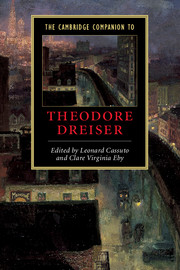Book contents
- Frontmatter
- Introduction
- Part I Backgrounds and contexts
- Part II Dreiser and his culture
- 5 The matter of Dreiser’s modernity
- 6 Dreiser, class, and the home
- 7 Can there be loyalty in The Financier? Dreiser and upward mobility
- 8 Dreiser, art, and the museum
- 9 Dreiser and women
- 10 Sister Carrie, race, and the World’s Columbian Exposition
- 11 Dreiser’s sociological vision
- 12 Dreiser and crime
- Select bibliography
- Index
9 - Dreiser and women
from Part II - Dreiser and his culture
Published online by Cambridge University Press: 28 May 2006
- Frontmatter
- Introduction
- Part I Backgrounds and contexts
- Part II Dreiser and his culture
- 5 The matter of Dreiser’s modernity
- 6 Dreiser, class, and the home
- 7 Can there be loyalty in The Financier? Dreiser and upward mobility
- 8 Dreiser, art, and the museum
- 9 Dreiser and women
- 10 Sister Carrie, race, and the World’s Columbian Exposition
- 11 Dreiser’s sociological vision
- 12 Dreiser and crime
- Select bibliography
- Index
Summary
In November 1913, Dreiser wrote his friend and literary champion, H. L. Mencken, “After I am dead please take up the mss of The Financier, Titan and Travel book and restore some of the woman stuff.” It may come as a surprise that considerable “woman stuff” was eliminated from The Financier (1912) and The Titan (1914), from A Traveler at Forty (1913), and indeed from many of Dreiser’s other works, for women do not exactly flicker in the sidelights of his writing. As heroines, lovers, and antagonists, they frequently share center stage, often even crowding out their male counterparts. Notably, two of his novels, Sister Carrie (1900) and Jennie Gerhardt (1911), take their titles from the names of female characters, while none display the proper names of men.
Now that a century’s discussion has passed, a trajectory has started to become evident in readers’ reactions to Dreiser’s portrayal of women. Until recently, two responses predominated. Those who disliked his writing frequently saw Dreiser’s non-judgmental treatment of “fallen women” as proof of his literary and/or moral ineptitude. Those who admired his books would often, to the contrary, laud his open treatment of sexuality and evident sympathy for women as an important aspect of his crusade against restrictive American “puritanism.” When the tide of feminist criticism beginning in the 1960s and 1970s began to crest on Dreiser, the discussion shifted, and an area of increasing concern became the extent of his investment in gender stereotypes. This question is complicated by the fact that, as Donald Pizer observes, most of Dreiser’s plots derive from popular literature - which itself can draw heavily from gender stereotypes. While some recent accounts depict Dreiser as challenging conventional views of women, many conclude that he is, in the words of one author, “Hell on Women.” In particular, examinations of Dreiser’s treatment of female sexuality often reach negative and even censorious conclusions.
- Type
- Chapter
- Information
- The Cambridge Companion to Theodore Dreiser , pp. 142 - 159Publisher: Cambridge University PressPrint publication year: 2004



